Photos with this report (click to enlarge) | |||
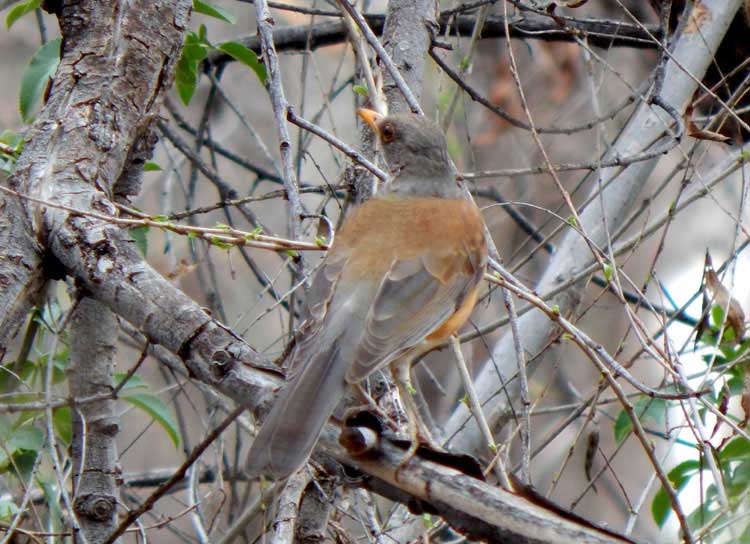 Rufous-backed Robin |
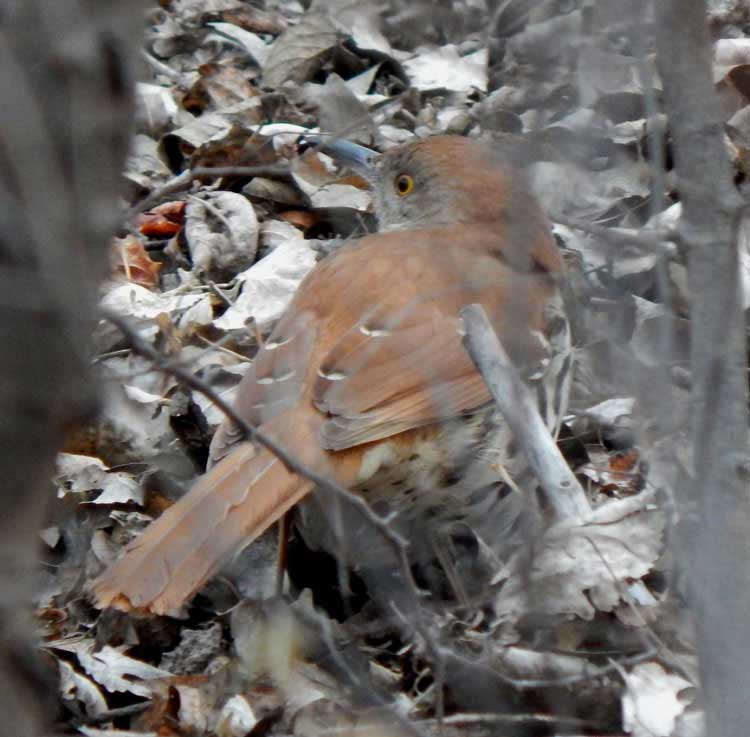 Brown Thrasher |
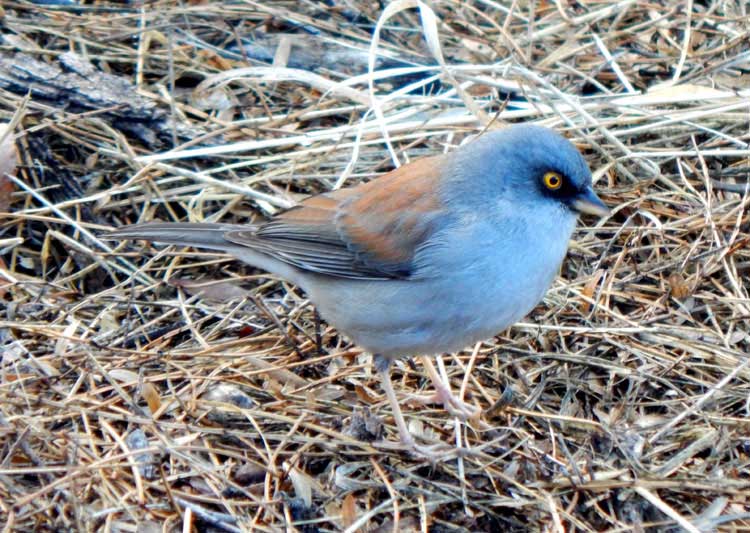 Yellow-eyed Junco |
|
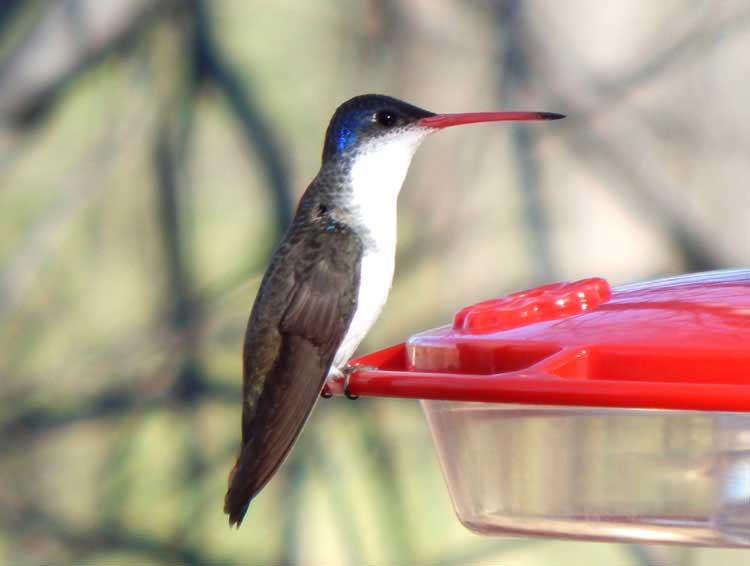 Violet-crowned Hummingbird |
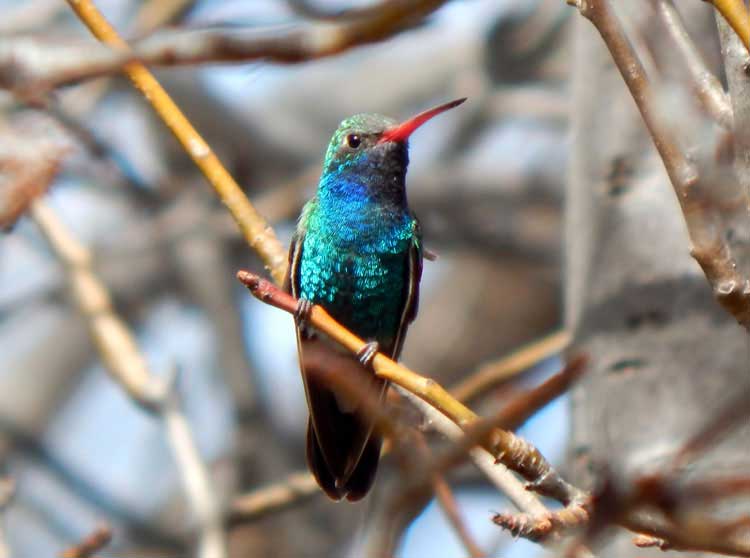 Broad-billed Hummingbird |
||
We spent 2.5 weeks in SE Arizona including a week birding in the Chiricahua Mountains, a week at Patagonia and 3 nights at Arivaca. We flew from Edinburgh using British Airways and hired a small Kia car through Budget rent-a-car. We saw 179 species and had great views of most of the SE Arizonan specialties that are present early in the season (a further raft of summer breeders do not arrive until April/May), plus a few bonus rarities such as Sinaloa Wren and Rufous-backed Robin. Key species missed were Elegant Trogon (the bird that used to winter at Patagonia Lake failed to appear in the 2017/18 winter) and Rose-throated Becard, whilst we saw none of the small owls. We used “a birder’s guide to SE Arizona” by Richard Cachor Taylor (highly recommended) and signed up to the excellent Arizona/New Mexico Bird e-mail alerts service, which put us on to several long-staying rarities.
Itinerary
• 26 Feb: arrived at 2300hrs at Tucson airport, stayed at the Best Western Hotel nearby
• 27 Feb: early morning birding in Tucson, then drove east via Wilcox to Cave Creek Ranch
• 28 Feb-4 Mar: stayed at Cave Creek Ranch and birded the Chiricahua Mountains, Portal and lower sites near Paradise and Rodeo
• 4 Mar: drove west from Portal through Douglas, Tombstone and Fairbank to Patagonia
• 5-11 Mar: stayed at Circle Z ranch, Patagonia and birded the ranch itself (vast), plus adjacent sites in Patagonia, Patagonia Lake, Sonoita and the San Rafael Grasslands
• 11 Mar: drove from Patagonia to Arivaca via birding at Tumacacori
• 12-14 Mar: stayed at Pandora Ranch, Arivaca and birded nearby sites: Arivaca Cienaga, Arivaca Creek, Arivaca Lake and the Buenos Aires National Wildlife Refuge
• 14 Mar: drove back to Tuscon and flew back to Edinburgh via Los Angeles
Principal sites
The main birding sites we birded are listed below.
1) Tucson:
a) Best Western Hotel. The shady gardens of the Best Western Hotel near the airport provided a few introductory species such as Vermillion Flycatcher, Black Phoebe, Yellow-rumped Warbler, Ruby-crowned Kinglet, Lesser Goldfinch, House Finch, Anna’s Hummingbird and great views of a perched Cooper’s Hawk, whilst the adjacent desert scrub held Verdin, Blue-grey Gnatcatcher, White-winged Dove and a nice flock of White-crowned Sparrows that also featured a lone Lincoln’s Sparrow.
b) Drive E/SE to Portal. A drive through the desert east of Tucson saw a range of common open country birds such as Red-tailed Hawk, American Kestrel and flocks of Chiricahuan Ravens and. A roadside rest stop at Texas Canyon produced a nice group of Western Bluebirds plus House Sparrows, whilst we saw our first Great-tailed Grackles in Wilcox. The desert along the smaller road between San Simon and Portal was more productive in the afternoon and we saw several Loggerhead Shrikes, Northern Harriers, Say’s Phoebes, Cactus Wrens, Greater Roadrunners, Lark Sparrows and a bonus Bendire’s Thrasher close to Rodeo.
2) Chiricahua Mountains:
a) Cave Creek Ranch. This gem of a site lies at the mouth of Cave Creek Canyon where it exits the SE corner of the Chiricahua Mountains. It is surrounded by spectacular canyon walls and harbours tall riparian forest as well as oak-juniper woodland and lower desert scrub. The bird feeders are probably the best stocked in the area and draw in a huge number and variety of birds, such that birding the grounds and watching the feeders will produce a large list of birds very quickly. Vast flocks of Pine Siskins and Lesser Goldfinches thronged the hanging seed feeders together with smaller numbers of House Finches, Cassin’s Finches and the odd American Goldfinch. Dozens of White-crowned Sparrows and Dark-eyed Juncos fed on the ground feeders and in amongst these were several Lincolns’ Sparrows, occasional Song Sparrows, Chipping Sparrows and at least one White-throated Sparrow. The Juncos repay close inspection as they include Oregon, Grey-headed and Pink-sided as well as at least one Rufous-backed and visiting groups of striking Yellow-eyed Juncos. Doves drawn into the feeders included White-winged, Inca, Mourning and Collared Doves, whilst other birds that came in from time to time were Mexican Jay, Cactus Wren, Bewick’s Wren, Pyrrhuloxia, Northern Cardinal and Bridled Titmouse. Ground birds under the feeders included Curve-billed Thrasher, Canyon Towhee and Spotted Towhee, plus occasional visits by Gambel’s Quail, which were common on the ranch. Peanut butter smeared on feeder trees attracted White-breasted Nuthatch, Arizona Woodpecker, Ladder-backed Woodpecker and noisy groups of Acorn Woodpeckers. Sugar-water feeders were dominated by wintering male Blue-throated Hummingbirds but at least one female Broad-tailed Hummingbird was present and there were male Magnificent (Rivoli’s) Hummingbirds on feeders in nearby gardens towards Portal. Away from the feeders, the rocky bed of Cave Creek held Canyon Wrens, tall trees held groups of American Robins, plus feeding groups of Ruby-crowned Kinglets, Hutton’s Vireos, Yellow-rumped Warblers and a superb bonus male Townsend’s Warbler. White-throated Swifts graced the canyon walls in the late afternoon, whilst raptors seen included Red-tailed Hawk, Sharp-shinned Hawk, Peregrine and Northern Goshawk. Grassland amongst oaks across the creek held a fine covey of Montezuma Quail. A path just across the road from the entrance led into low desert scrub, which could be pretty bird-less in the afternoon but first thing in the morning resounded to the song of Crissal Thrashers, which gave good views when perched up singing. The area also held singing Black-throated Sparrows, Black-chinned Sparrows, at least 2 Sage Thrashers and a group of Mountain Bluebirds that flew over west heading up the canyon. These top quality birds needed to be weeded out from larger numbers of more common species such as Cactus Wren, Verdin, Dark-eyed Junco, Mourning Dove, Ladder-backed Woodpecker, Gambel’s Quail, White-crowned Sparrow etc.
b) South Fork. This well-known site was scenically very attractive although relatively bird-less so early in the season compared to Cave Creek. Commonest birds here and indeed throughout the Chiricahuas were mixed parties of Ruby-crowned Kinglet, Hutton’s Vireo, White-breasted Nuthatch, Bridled Titmouse, Bewick’s Wren and a few Yellow-rumped Warblers, but here they also included Brown Creeper and Yellow-eyed Junco, plus the odd lone Hermit Thrush and more Canyon Wrens on the rocky creek-banks. A large flock of Bushtits was new here and we saw some 6 Wild Turkey along the roadside plus a stunning Painted Redstart. Tall trees beyond the road-end held Red-shafted Flicker and Hairy Woodpecker plus our first Turkey Vulture and Northern Raven, although we failed to find Mexican Chickadee further up the trail here.
c) Ash Spring. We took a nice walk from the Herb Martyr Campground up round to Ash Spring and back. This held the typical Chiricahua mixed species flocks as in South Fork but the higher elevation pines at Ash Spring held Steller’s Jay and Hairy Woodpecker, with a bonus Winter Wren in the brush-piles there.
d) Higher mountains. We drove up into the Chiricahuas to check out some higher altitude habitats. The pines at East Turkey Creek crossing produced at least 4 of the hoped-for Mexican Chickadee, more Steller’s Jays, Red-naped Sapsucker and a bonus Costa’s Hummingbird that was drawn to Janet’s pink top, plus our first Red-breasted Nuthatch. The road was blocked by a fallen tree and snow just before Onion Saddle but this area produced more Mexican Chickadees, Red-breasted Nuthatch and our only Pygmy Nuthatches of the trip.
e) Silver Creek and Paradise. We made several stops along the road to Paradise in order to sample the birds of this relatively lush desert and to reach the taller trees along Silver Creek itself. Typical desert birds here included Verdin, Bushtit, Black-tailed Gnatcatcher, Curve-billed and Crissal Thrashers, Western (Woodhouse’s) Scrub-jay and Vesper Sparrow but we also had a group of 4 Mountain Bluebirds here and at least 1 Townsend’s Solitaire. The taller trees along the creek held the hoped-for Juniper Titmouse as well as more Red-naped Sapsuckers and a noisy rattlesnake! A small pool at the main parking area gave great views of birds coming in to drink including American Robin and Spotted Towhee. The well-stocked feeders at the George Walker house at Paradise provided nice views of Mexican Jay, Bridled Titmouse, Pine Siskin, Dark-eyed Junco etc and more White-crowned Sparrows.
f) Stateline Road to Willow Tank. This quiet dirt road runs the state-line between Arizona and New Mexico just west of Rodeo, passing through low desert with some agriculture. The scrub and fence-lines were awash with large flocks of sparrows, which included Brewer’s, Vesper, Lark, Black-throated, White-crowned, Chipping and Savannah Sparrows, plus a large flock of Lark Buntings close to Willow Tank. Scaled Quail were new here and we had good views of more Bendire’s Thrashers including one at Willow Tank itself, plus large flocks of Brewer’s Blackbirds on the wires. Irrigated fields close to Willow Tank produced flocks of Killdeer, Western Meadowlarks and more Greater Roadrunners, whilst raptors included Red-tailed Hawks, Northern Harriers and at least 2 Harris Hawks on Sulphur Draw road beyond Willow Tank. Willow Tank itself held a small group of Ring-necked Ducks and American Coot, with Marsh Wren and Swamp Sparrow in the reeds and Song Sparrows on the edge. Mixed flocks of dabbling ducks had apparently been present a few days before during a late snowfall. We checked the draw behind the tank for longspurs but had no luck here.
3) Patagonia area
a) Circle Z ranch. We stayed in the very comfortable lodging here. I birded every day while Janet rode the range on horse-back. This private ranch is vast and includes a long stretch of the Patagonia-Sonoita Creek, between the public preserves at Patagonia and Patagonia Lake, as well as extensive areas of well-vegetated Sonoran desert, canyons, rocky hills and grassland. The first morning’s birding along the creek was truly outstanding and this proved to be an excellent spot for migrants as new birds appeared here each day. Scarce / local species here included at least 3 Green Kingfishers, Brown Thrasher, Hepatic Tanager, Cassin’s Vireo, Cassin’s Finch and Red-breasted Nuthatch (rare in this habitat/low elevation), as well as a host of news birds such as Green-tailed Towhee, Abert’s Towhee, Grey Flycatcher, Dusky Flycatcher, Gilded Flicker, Phainopepla, House (Brown-throated) Wren, Great Blue Heron, Great White Egret and Belted Kingfisher, plus many other more widespread species already encountered such as Western Bluebird and flocks of American Robins and Red-shafted Flickers. Migrants included Violet-green Swallow, Ash-throated Flycatcher, Warbling Vireo, Black-throated Grey Warbler, Yellow Warbler and Lucy’s Warbler. The grass lawns and flower-beds around the accommodation hosted Gila Woodpecker, White-winged Dove, Inca Dove, Anna’s and Broad-billed Hummingbirds, Vermillion Flycatcher, Say’s Phoebe, Black Phoebe, Canyon Towhee, Vesper Sparrow and House Finch, whilst the horse pens had large flocks of Brewer’s Blackbirds, Lark Sparrows, Wild Turkeys, Inca Doves and a few Common Ground-doves. The scrubby slopes of the rocky mountain across the creek held Rufous-crowned Sparrow as well as Black-chinned Sparrow, Black-throated Sparrow and Black-tailed Gnatcatcher, with Rock Wrens on the cliffs near the top and a soaring Common Black Hawk in with the Black and Turkey Vultures. The extremely localised Five-striped Sparrow has bred here in the past and is well worth searching for.
b) Patton’s home. The well-stocked sugar-water feeders in this fantastic garden attracted a wide range of hummingbirds and repaid repeated visits. In amongst the many Anna’s Hummingbirds, were several stunning Violet-crowned Hummingbirds – this is the place to see them in the US – plus Broad-billed, Costa’s, Black-chinned and Rufous Hummingbirds. The seed feeders were also good for Cassin’s Finch, Green-tailed Towhee, Abert’s Towhee, Song Sparrow, Lincoln’s Sparrow, Phainopepla, Pine Siskin and a bonus rarity in the form of a Ruddy Ground-dove. Lazuli Buntings are also seen here regularly but we missed these.
c) Patagonia Lake. An early morning visit to nearby Patagonia Lake was well worth the $14 entrance fee. The lake itself held lots of waterbirds including a long-staying Greater Scaup in with the Lesser Scaups, lots of Ruddy Ducks and Black-necked (Eared) Grebes, smaller groups of Common Merganser, Gadwall, Mexican Duck, Green-winged Teal and Cinnamon Teal, the odd Neotropic Cormorant in with the Double-crested Cormorants, plus a few Wilson’s Snipe and a Great Blue Heron along the shore. Feeders near the boat dock held common birds including Great-tailed Grackles and Lesser Goldfinch, whilst the edge of the reedy inlet held a bonus local rarity in the form of a singing Carolina Wren. The reserve at the east end of the lake along the creek was very birdy with 2 long-staying Black-capped Gnatcatchers, a roosting Great Horned Owl, a Black-throated Grey Warbler, Hammond’s Flycatcher and a perched adult Cooper’s Hawk the standouts, with good views also of Green-tailed Towhee, Abert’s Towhee and my first Rufous-winged Sparrows on the edge of the dry mesquite bosque.
d) Sonoita grasslands. These excellent grasslands are a quick drive up from Patagonia. Early morning saw several Grasshopper Sparrows perched on the lower rungs of roadside fences just east of town together with many Eastern (Lillian’s) Meadowlarks, Savannah Sparrow, Vesper Sparrow, Black-throated Sparrow, Northern Harriers, my only Swainson’s Hawk of the trip and close-up views of Pronghorns. A watering hole on the Davis Pasture accessed by rough track through a gate on the south side of the road is a well-known stake-out for longspurs. Flighty groups of 30+ Chestnut-collared Longspurs would drop in to drink but then leave almost immediately leaving behind odd single birds, which could be enjoyed more closely. A dry bare area at the back of the pool held many Horned Larks, a male Lapland Longspur that was already close to full summer plumage plus up to 5 McCown’s Longspurs including at least 2 males that were beginning to come into summer plumage. The grasslands and watering hole abounded with sparrows – mostly Savannah, Vesper and Brewer’s Sparrows but I bumped into 3 sneaky Baird’s Sparrows in tall grass near the track as I walked to the watering hole, plus an even more secretive Cassin’s Sparrow.
e) San Rafael grasslands. We drove out to these excellent grasslands SE of Patagonia with the horses from the Ranch for riding and I then walked out on foot. Scrubby slopes before the grasslands held more Rufous-crowed Sparrows, Mexican Jays in the oaks and lots of migrant Violet-green Swallows passing through. The open grasslands themselves produced several Eastern (Lillian’s) Meadowlarks, Vesper Sparrows and Savannah Sparrows, with Chestnut-collared Longspurs and a vocal Sprague’s Pipit in a short grass area and a lone Baird’s Sparrow in taller grass, plus 5 Ring-necked Ducks on a pool.
4) Tumacacori. This site was en route between Patagonia and Arivaca and was known to be holding good birds, so we gave it a good 2 hour’s birding in the late morning. We birded the Santa de Anza trail south from the Santa Gerudis Lane and found the sunlit riverside trees to be very birdy. Some birders already present put us on to the long-staying Sinaloa Wren beyond the area with several old dumped cars. The river edge here also held lots of Wilson’s Warblers, Yellow-rumped, Orange-crowned and Yellow Warblers, plus a pair of Hepatic Tanagers. A quiet watch of birds coming to drink at the water’s edge produced 2 stunning Rufous-backed Robins. We didn’t see the male Rose-throated Becard however, which was reportedly north of the road, although we did pick up our only Cassin’s Kingbird of the trip here at the woodland edge.
5) Arivaca.
a) Pandora Guest Ranch. We stayed at the Pandora Guest Ranch, south of Arivaca along Ruby Road. The tall planted trees and watered lawns were a magnet for birds from the surrounding desert scrub allowing great views of Gambel’s Quail, Phainopepla, Pyrrhuloxia, Curve-billed and Sage Thrashers, Loggerhead Shrike, Canyon Towhee, Gila Woodpecker, Cactus Wren, Vermillion Flycatcher, Say’s Phoebe, Northern Mockingbird, Northern Harrier, Black-throated Sparrow in amongst other commoner species and best of all 2 Rufous-winged Sparrows.
b) Arivaca Lake. This popular boating and fishing lake was quite busy but held a few birds including several American Coot, Double-crested Cormorant, Ruddy Duck, Ring-necked Duck, Pied-billed Grebe, 2 Mexican Duck, a pair of Cinnamon Teal and a Blue-winged Teal, plus Violet-green and Northern Rough-wing Swallows over the lake and quite a few of the commoner sparrows and desert birds in the surrounding scrub.
c) Arivaca Cienaga. This excellent-looking wetland area was essentially devoid of water bar from one tiny puddle in the creek bed, so birds were hard to come by. Scrub patches held Green-tailed, Canyon and Abert’s Towhees, a few Yellow-rumped Warblers and a Dusky Flycatcher in amongst the usual Vermillion Flycatchers and Say’s Phoebes, whilst the cat-tails and scrub hid skulking groups of sparrows that included White-crowned, Lincoln’s, Chipping, Song, Swamp, Rufous-winged and one slate-coloured Fox Sparrow – our only one of the trip. The wide-open skies here were good for raptor watching with lots of Turkey Vultures, a few Red-tailed Hawks and American Kestrels plus a bonus distant Golden Eagle.
d) Arivaca Creek. Sadly, the creek was dry except for one pool at the first parking area heading west from Arivaca. The better site was the second parking area, which gave access to more extensive trails running through the tall riverine habitat. Best bird here was a bonus Brown Thrasher but it was very birdy in the early morning with several Red-naped Sapsuckers, Grey Flycatcher, Green-tailed, Abert’s and Canyon Towhees, Hermit Thrushes and a House (Brown-throated) Wren in amongst commoner fare, plus Rufous-winged Sparrow, Ladder-backed Woodpecker and Crissal Thrasher in the adjacent desert scrub.
e) Buenos Aires NWR. Again the reserve was mostly dry so a small cat-tail lined pond along the entrance road, which was being kept top-up with water was a magnet for many birds. These included 2 Common Yellowthroats, Marsh Wren and Violet-green Swallows, plus a flock of 50+ Red-winged Blackbirds, which also contained a dozen Brown-headed Cowbirds. Trails heading out from the visitor centre held a good range of commoner dry country birds including many Eastern (Lillian’s) Meadowlarks in a dried up lake-bed, Abert’s Towhee, Loggerhead Shrike, Northern Harrier and 4 more Rufous-winged Sparrows.